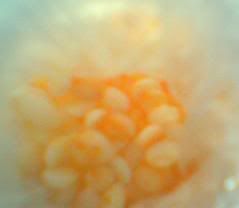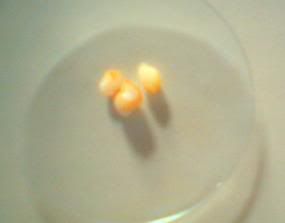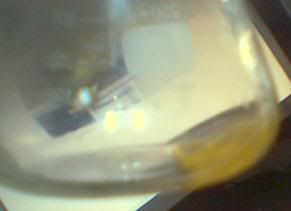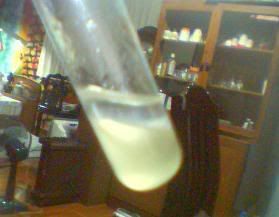Pomzazed
Hazard to Self
 
Posts: 57
Registered: 15-9-2008
Location: In th' Lab
Member Is Offline
Mood: Acylated
|
|
NaOH turns yellow!?
Yesterday I managed to rearrange my old chemical stash and found out that my 99.0% NaOH pallet has turned yellow and orange!
It seems appear creeping from the surface of the tablet to inside, which start from bright yellow to bright orange. (similar color to chromate then
dichromate)
It is stored in plastic bag, closed, then inside the normal plastic chemical bottle - tightly closed- for around three years. The bottle is tight
enough that NaOH pallet doesnt absorb moisture from air and remains as solid (no sticky goo from its deliquiscent property)
The change appears on entire bottle of 100g.
Any idea what happened to my NaOH?
(Just curious, dont want to discard it via curiosity...)
Edit: At first I was thinking about peroxide and superoxide, but that would from from the oxidation of metal sodium. But this is originally hydroxide
pellt, plus entire bottle?!
Edit2: The bottle isn't exposed to light at all.
[Edited on 15-9-2008 by Pomzazed]
|
|
|
Pomzazed
Hazard to Self
 
Posts: 57
Registered: 15-9-2008
Location: In th' Lab
Member Is Offline
Mood: Acylated
|
|
Seems not to be a peroxide.
The yellow thing creeps down from the pellet surface.
I drop 3 pellt. into small amount of water. They dissolve nicely showing the white surface after dissolving into about half-sized.
Once completely dissolved. I obtain a clear yellow solution!.
Images attach are not quite well focused. Captured from my webcam
Fig1: Inside Bottle

Fig2: Pallets on watchglass

Fig3: When dissolved in water

Any ideas?
|
|
|
Nerro
National Hazard
   
Posts: 596
Registered: 29-9-2004
Location: Netherlands
Member Is Offline
Mood: Whatever...
|
|
in K<sub>2</sub>O something similar seems to happen, it that case I vaguely remember it being the superoxide.
#261501 +(11351)- [X]
the \"bishop\" came to our church today
he was a fucken impostor
never once moved diagonally
courtesy of bash
|
|
|
kmno4
International Hazard
    
Posts: 1497
Registered: 1-6-2005
Location: Silly, stupid country
Member Is Offline
Mood: No Mood
|
|
Strange.
If your NaOH has no any specific impurities, then the only reason that comes to my mind is your plastic bag  I mean some compounds (additives, antioxidants, monomers... ?) evoluted from this plastic and reacted with NaOH. I mean some compounds (additives, antioxidants, monomers... ?) evoluted from this plastic and reacted with NaOH.
Or maybe there was any possibility of contact with bromine or iodine ? These elements easily permeate through any plastic.
I have 10 years old NaOH (glass jar), 5 years old KOH (PP container) - still white and almost no carbonates.
|
|
|
ScienceSquirrel
International Hazard
    
Posts: 1863
Registered: 18-6-2008
Location: Brittany
Member Is Offline
Mood: Dogs are pets but cats are little furry humans with four feet and self determination! 
|
|
It is definitely not a peroxide or superoxide as they would be decomposed on dissolving in water.
I think bromine or iodine would react with the strong base to form halides and oxyhalides.
I would suggest that plasticiser from the bag has been absorbed into the pellets and has condensed under the strongly basic conditions to form
coloured material.
|
|
|
Pomzazed
Hazard to Self
 
Posts: 57
Registered: 15-9-2008
Location: In th' Lab
Member Is Offline
Mood: Acylated
|
|
- At first i think its (sup)eroxides too, but it then I know it isnt after it gives yellow clear solution in water.
- As for impurity, mine is lab grade NaOH.
- I have no iodine, bromine, nor iodide, bromide, etc in that cabinet too!
- The plastic bag? it is still looks good, no decoloration, no lost of elasticity and no sign of degradation ever...
It still looks like a new plastic bag (its a PE plastic bag, inside PP bottle). Though I cannot say the plasticiser is impossible, it looks quite
unlikely to me! since every palletes of NaOH got the yellow color in the similar intensity, not matter if it is inside, or at the contact of the
plastic bag. If the plasticiser is volatile and forms the color, the outermost pelletts should get more intense color, but this is not the case! O_o
I'm still investigating on this.
But reactions wont help much, since most of it is still NaOH :S So I still cant decide what reaction(s) should i use to investigate on.
|
|
|
ScienceSquirrel
International Hazard
    
Posts: 1863
Registered: 18-6-2008
Location: Brittany
Member Is Offline
Mood: Dogs are pets but cats are little furry humans with four feet and self determination! 
|
|
You could try extracting the solution with an organic solvent. Try something fairly polar like ether or dichloromethane.
As any organic chemist will tell you, a tiny amount of brown goo goes a long way...
I think that the fact your pellets are colouring from the outside in is a strong indication of some volatile from the bag being absorbed.
[Edited on 16-9-2008 by ScienceSquirrel]
|
|
|
panziandi
Hazard to Others
  
Posts: 490
Registered: 3-10-2006
Location: UK
Member Is Offline
Mood: Bored
|
|
Indeed I would hazard a guess it's a plasticiser being absorbed by the hydroxide which is causing it to condense. My hydroxides are all in plastic
jars and some are rather old whether its T, LR or AR they are all still white. I'm sure it's something from the plastic bag!
|
|
|
Pomzazed
Hazard to Self
 
Posts: 57
Registered: 15-9-2008
Location: In th' Lab
Member Is Offline
Mood: Acylated
|
|
| Quote: | Originally posted by ScienceSquirrel
I think that the fact your pellets are colouring from the outside in is a strong indication of some volatile from the bag being absorbed.
[Edited on 16-9-2008 by ScienceSquirrel] |
-It isnt coloring from the outside, i said the color is similar despite outside or innermost pellets.
I'll perform a solvent extraction soon and report what i get.
GC-MS isnt available to me at this moment.
Don't stare at me making fumes... I'm just experimenting with some gas...
|
|
|
ScienceSquirrel
International Hazard
    
Posts: 1863
Registered: 18-6-2008
Location: Brittany
Member Is Offline
Mood: Dogs are pets but cats are little furry humans with four feet and self determination! 
|
|
Sorry crossed wires there.
I meant that the cores of the pellets are white while the outside material is coloured, similar to a gobstopper!
This would be consistent with a volatile contaminant that slowly diffused through the mass of pellets.
|
|
|
panziandi
Hazard to Others
  
Posts: 490
Registered: 3-10-2006
Location: UK
Member Is Offline
Mood: Bored
|
|
Will you be extracting an aqueous solution or the solid? Either way I don't recommend DCM as the solvent may decompose a little. Use Et2O or an
aromatic solvent first. How does it respond to changes in pH? Try neutralising the solution with HCl or H2SO4 and see how it reacts.
|
|
|
ScienceSquirrel
International Hazard
    
Posts: 1863
Registered: 18-6-2008
Location: Brittany
Member Is Offline
Mood: Dogs are pets but cats are little furry humans with four feet and self determination! 
|
|
Dichloromethane is completely inert to cold sodium hydroxide of a few molar concentration.
Make a solution of the pellets and then try shaking small aliquots with a selection of solvents in test tubes.
|
|
|
Pomzazed
Hazard to Self
 
Posts: 57
Registered: 15-9-2008
Location: In th' Lab
Member Is Offline
Mood: Acylated
|
|
| Quote: | Originally posted by ScienceSquirrel
I meant that the cores of the pellets are white while the outside material is coloured, similar to a gobstopper!
This would be consistent with a volatile contaminant that slowly diffused through the mass of pellets. |
Agreed.
| Quote: | Originally posted by panziandil
[1]Will you be extracting an aqueous solution or the solid?
[2]Try neutralising the solution with HCl or H2SO4 and see how it reacts. |
[1] from aqueous solution
[2] the color doesnt change at pH neutral, however when become highly acidic (via several drops of conc.HCl) it got discolored slightly and i'm sure
its not from the dilution.
The color has a very tiny green tint added. "very tiny change but not the same color"
----------
And... to my surprise. I thought it should be some organic compounds. but now what? Here's the result from solvent extraction.
The Yellow does not dissolve in n-hexane, Toluene, DCM, Ethyl Acetate despite their different polarity. They all stay in the aqueous phase!!
Fig 4: Dissolved yellow NaOH in water/toluene. (The turbid is from shaking emulsion)

If the yellow is some kind of organic cpds, it should at least dissolve in the solvent selected, because i select some range of polarity, and it just
isn't.
This brings me more curiosity now. Hmm...
Edit: It is polar enough to dissolve in methanol and ethanol.
[Edited on 16-9-2008 by Pomzazed]
Don't stare at me making fumes... I'm just experimenting with some gas...
|
|
|
ScienceSquirrel
International Hazard
    
Posts: 1863
Registered: 18-6-2008
Location: Brittany
Member Is Offline
Mood: Dogs are pets but cats are little furry humans with four feet and self determination! 
|
|
If you have not already done so you could try extracting the acidified solution with an organic solvent.
The compound may be acidic enough to form an anion with the strong base so it will not extract.
|
|
|
not_important
International Hazard
    
Posts: 3873
Registered: 21-7-2006
Member Is Offline
Mood: No Mood
|
|
Polyethylene generally doesn't have plastisers added, it is even used as a plastiser occasionally. But it can have antioxidants and UV-stabilizers
added, these can be hindered amines, aromatic compounds, and metal-based compounds. The diffusion of these out of the PE would not change its
physical properties to any easily noticeable degree, as it was kept out of sunlight and away from exposure to ozone. Exactly what might be in there
is difficult to tell, especially without knowing the intended us of the bags (food grade uses different additives) but here's some examples http://www.tramaco.com/PI/englisch/eng-PE-Extrusion.pdf noting that blowing agents are for foam products.
Could be interesting to use HCl to bring the pH to 7, evaporate to dryness, and then try extracting starting with the least polar solvent and working
towards MeOH as the last solvent tried.
[Edited on 16-9-2008 by not_important]
|
|
|
woelen
Super Administrator
        
Posts: 8012
Registered: 20-8-2005
Location: Netherlands
Member Is Offline
Mood: interested
|
|
I have observed the same thing. I had pure NaOH and put some of this in a glass jar, together with some little 30 ml bottles of HNO3. I did the NaOH
in the jar, to be sure that any vapors of acid are absorbed in the NaOH. This works like a charm. The NaOH, however turned orange after some time. I
have the little bottles of HNO3 wrapped in plastic bags, just to be sure that the bottles cannot hit each other.
I have a similar type of storage in another jar, but this has no plastic in it, just three little (30 ml) bottles and an open bottle of NaOH. In the
latter, the NaOH remains white (but somewhat crusty, due to absorption of acid).
|
|
|
DJF90
International Hazard
    
Posts: 2266
Registered: 15-12-2007
Location: At the bench
Member Is Offline
Mood: No Mood
|
|
I guess that means the plastic bag is the culprit. I would sugeest keeping the NaOH in the bottle, and then if necessary put the bottle in a plastic
bag (so that the bag is not in direct contact with the NaOH).
|
|
|
Pomzazed
Hazard to Self
 
Posts: 57
Registered: 15-9-2008
Location: In th' Lab
Member Is Offline
Mood: Acylated
|
|
I'm experimenting what woelen has said.
This will take some time before i can report the result 
And yes I do have conc. Nitric bottle in the shelf too. and it stands quite near to where the NaOH bottle was at.
guess that HNO3 vapor might do something to plasticiser by nitrating it rendering its yellow and got absorbed by NaOH.
I will report later if the test is positive or not.
Don't stare at me making fumes... I'm just experimenting with some gas...
|
|
|
Pomzazed
Hazard to Self
 
Posts: 57
Registered: 15-9-2008
Location: In th' Lab
Member Is Offline
Mood: Acylated
|
|
*Result*
-Failed to duplicate the yellow-orange surface with nitric acid vapour and its own plastic bag. :S
Don't stare at me making fumes... I'm just experimenting with some gas...
|
|
|
woelen
Super Administrator
        
Posts: 8012
Registered: 20-8-2005
Location: Netherlands
Member Is Offline
Mood: interested
|
|
I am not surprised about this result. The problem with all this kind of things is that not all variables are known. There are so many types of
plastic, the type of jar and cap may have an influence as well.
I personally think, this is due to some plastic, maybe even without HNO3. Did you never notice the smell of a plastic bag, just taken out of its roll.
It might well be due to this compound, which can be trapped when in a closed vessel, in which the NaOH also is.
|
|
|
dobeid
Harmless

Posts: 7
Registered: 19-9-2008
Member Is Offline
Mood: No Mood
|
|
NAOH liquid vs. Crystals/Flakes?
I was just wondering if a reaction calls for liquid NAOH can NAOH flakes/crystals be used instead?
|
|
|
dobeid
Harmless

Posts: 7
Registered: 19-9-2008
Member Is Offline
Mood: No Mood
|
|
NAOH liquid vs. Crystals/Flakes?
I was just wondering if a reaction calls for liquid NAOH can NAOH flakes/crystals be used instead?
|
|
|
DJF90
International Hazard
    
Posts: 2266
Registered: 15-12-2007
Location: At the bench
Member Is Offline
Mood: No Mood
|
|
If it says use a solution then i wouldnt deviate from that.
|
|
|
ScienceSquirrel
International Hazard
    
Posts: 1863
Registered: 18-6-2008
Location: Brittany
Member Is Offline
Mood: Dogs are pets but cats are little furry humans with four feet and self determination! 
|
|
If you have a recipe than stick to it.
Often thay will have tried a lot of different conditions before settling on the published ones. You are profiting from their failures!
|
|
|